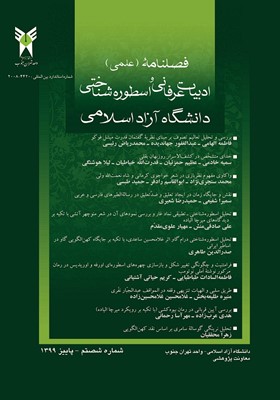تحلیل اسطورهشناختی درام گاو اثر غلامحسین ساعدی، با تکیه بر جایگاه کهنالگویی گاو در اساطیر ایرانی
محورهای موضوعی : اسطوره
1 - استادیار پژوهش هنر دانشکده پژوهشهای عالی هنر و کارآفرینی دانشگاه هنر اصفهان
کلید واژه:
چکیده مقاله :
در اندیشة فرهنگهای جانمندانگار، جانور برگزیده، نمایندة نیرویی ازلی است که برای کفارة گناهان یا برکتبخشی باید قربانی گردد. گاه انسان برگزیده و جانور برگزیده در قربانگاه جانشین یکدیگر میگردند. این قربانیِ جانشین، در ادیان ابراهیمی اغلب شتر یا گوسفند است، اما نگاهی به انگارههای مرتبت با گاو در باورهای پیش از اسلام ایران، آشکار میسازد که قربانی برگزیده برای ایرانیان باستان گاو بوده است که در سیمایی کهنالگویی با قربانی شدن خود سبب برکت یافتن طبیعت میگردد. هدف این پژوهش تاریخی با روش توصیفی ـ تحلیلی و توسعهای که دادههای کیفی آن به شیوة اسنادی گردآوری شدهاند، پیجویی ریشههای اساطیری درام گاو اثر غلامحسین ساعدی با رویکرد اسطورهشناسی تطبیقی است. نتیجه پژوهش آشکار میسازد که کنشگران اساطیری این روایت عبارتند از: شمن (مشاسلام)، راهبهها (ننه خانم و ننه فاطمه)، قوای اهریمنی (راهزنان پوروسی)، قربانی جانوری (گاو)، و قربانی انسانی (مشحسن). پس از مرگ گاو، مشحسن جانشین او میگردد و در نهایت او نیز دچار مرگی همسان گاو میشود تا مرز میان دو قربانی انسانی و جانوری از میان برداشته شود.
In animist cultures, the chosen animal represents an eternal power, which needs to be ritually sacrificed to blessing or as atonement for sins. In an altar, sometimes the chosen man and the chosen animal substitute one another. In the Abrahamic religions, the successor sacrifice is often a camel or a sheep. But taking a look at pre-Islamic Iranian beliefs reveals that for the ancient Iranians the chosen animal is cow which in its archetypal role, as the sacrifice, blesses the nature. The purpose of the present article is to explore the mythological roots in Gāv (The Cow), a screenplay by Gholām-Hossein Sā'edi, with a comparative mythological approach. The research has been done by using descriptive-analytical and developmental method and its qualitative data have been collected in a documentary manner. The result of the research reveals that the mythological actors of this narrative are as follows: the shaman (Mash Islam), the nuns (Naneh Khanom and Naneh Fatemeh), the devilish powers (the Porusi bandits), the sacrificial animal (the cow) and the sacrificial man (Mash Hasan). After the cow dies, Mash Hasan substitutes for it, and eventually he suffers the same death as the cow. In this way, the border between the sacrificial animal and the sacrificial man is abolished.

